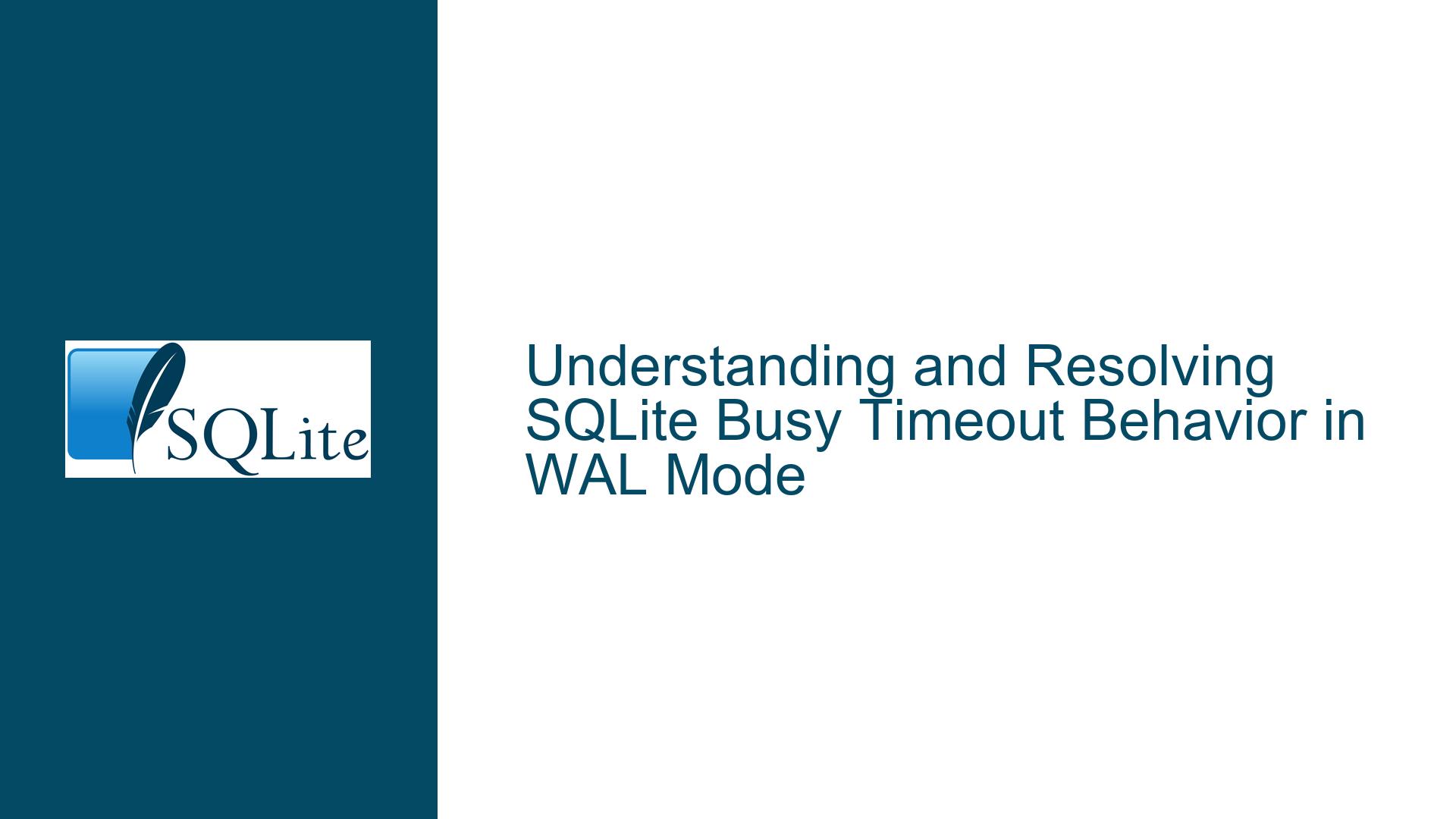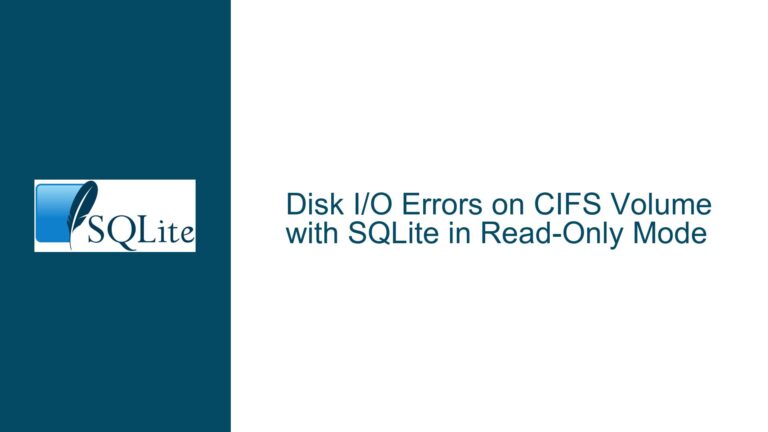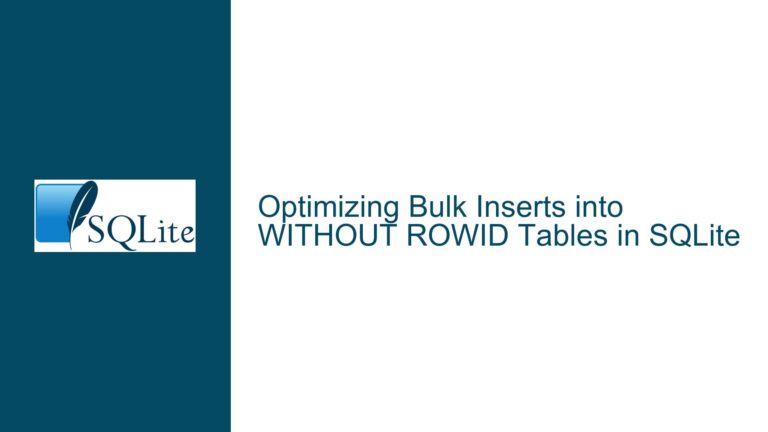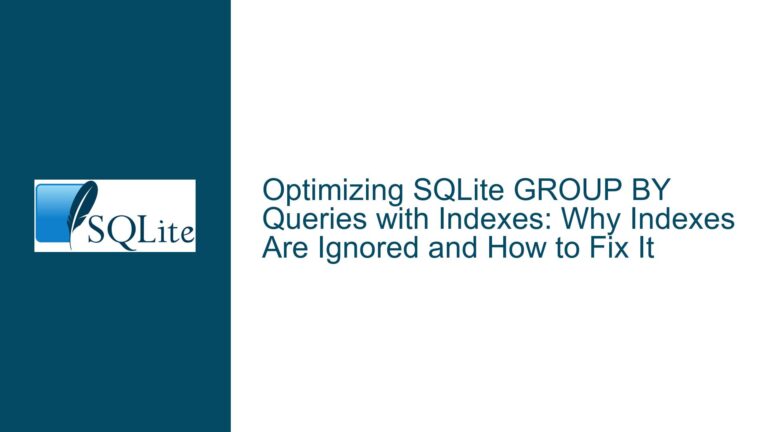and Resolving SQLite Busy Timeout Behavior in WAL Mode
Issue Overview: SQLite Busy Timeout Not Enforcing Wait in WAL Mode
When working with SQLite in a multi-process environment, particularly when one process is performing read operations while another is concurrently writing to the database, understanding the behavior of sqlite3_busy_timeout is crucial. The sqlite3_busy_timeout function is designed to introduce a delay before returning a SQLITE_BUSY error, allowing the database to resolve contention issues by waiting for a specified period. However, in the described scenario, the read operation sometimes returns no matching records immediately, even though the same query executed at a different time retrieves the expected data. This behavior suggests that the sqlite3_busy_timeout is not functioning as intended, particularly when the database is in Write-Ahead Logging (WAL) mode.
The core issue revolves around the interaction between the sqlite3_busy_timeout function and WAL mode. WAL mode is designed to allow concurrent read and write operations by maintaining separate write and read transactions. However, the behavior of sqlite3_busy_timeout in WAL mode can be nuanced, and its effectiveness depends on several factors, including the database’s configuration, the nature of the queries, and the timing of read and write operations.
Possible Causes: Why SQLite Busy Timeout May Not Work as Expected in WAL Mode
The behavior observed in the scenario can be attributed to several underlying causes, each of which interacts with the WAL mode and the sqlite3_busy_timeout function in specific ways.
1. WAL Mode and Concurrent Access:
WAL mode is designed to allow multiple readers and a single writer to operate concurrently without blocking each other. In WAL mode, readers do not block writers, and writers do not block readers. This is achieved by maintaining a separate write-ahead log that allows readers to continue accessing the database while writes are being performed. However, this concurrency model can lead to situations where a read operation might not see the latest changes made by a concurrent write operation, especially if the write operation has not yet been committed or if the read operation is not properly synchronized with the write operation.
2. Busy Timeout and WAL Mode Interaction:
The sqlite3_busy_timeout function is primarily designed to handle situations where a database operation cannot proceed because the database is locked by another operation. In WAL mode, the locking mechanism is different from the traditional rollback journal mode. In WAL mode, the sqlite3_busy_timeout function may not be as effective because the database is not locked in the same way. Instead, WAL mode uses a more granular locking mechanism that allows for greater concurrency but can also lead to situations where a read operation might not wait for a write operation to complete, even if the sqlite3_busy_timeout is set.
3. Query Timing and Transaction Boundaries:
The timing of the read and write operations can also play a significant role in the observed behavior. If the read operation is executed at a time when the write operation has not yet committed its changes, the read operation might not see the latest data. This can happen even if the sqlite3_busy_timeout is set, because the timeout is designed to handle locking conflicts, not to ensure that the read operation sees the latest committed data. Additionally, if the read operation is not properly synchronized with the write operation, it might not wait for the write operation to complete, leading to the observed behavior.
4. Database Configuration and WAL Mode Settings:
The configuration of the database and the specific settings of WAL mode can also impact the behavior of sqlite3_busy_timeout. For example, the size of the WAL file, the checkpointing strategy, and the frequency of commits can all influence how read and write operations interact. If the WAL file is too small, it might lead to frequent checkpoints, which can increase contention and reduce the effectiveness of sqlite3_busy_timeout. Similarly, if the checkpointing strategy is not optimized for the workload, it might lead to situations where read operations do not see the latest changes.
Troubleshooting Steps, Solutions & Fixes: Ensuring Proper Behavior of SQLite Busy Timeout in WAL Mode
To address the issue of sqlite3_busy_timeout not enforcing the expected wait in WAL mode, several troubleshooting steps and solutions can be implemented. These steps are designed to ensure that the database is properly configured, that the read and write operations are properly synchronized, and that the sqlite3_busy_timeout function is used effectively.
1. Verify and Enable WAL Mode:
The first step is to ensure that the database is indeed in WAL mode. This can be done by executing the following SQL command: PRAGMA journal_mode=WAL;. This command should be executed exactly once on the database to enable WAL mode. If the database is not in WAL mode, enabling it can significantly improve concurrency and reduce contention between read and write operations.
2. Optimize WAL Mode Settings:
Once WAL mode is enabled, it is important to optimize the settings for the specific workload. This includes setting an appropriate size for the WAL file and configuring the checkpointing strategy. The size of the WAL file can be set using the PRAGMA wal_autocheckpoint command, which determines how often the WAL file is checkpointed. A larger WAL file can reduce the frequency of checkpoints and improve concurrency, but it also increases the amount of disk space used by the database. The checkpointing strategy can be configured using the PRAGMA wal_checkpoint command, which allows for manual or automatic checkpointing.
3. Synchronize Read and Write Operations:
To ensure that read operations see the latest changes made by write operations, it is important to properly synchronize the two. This can be done by using transactions to group related read and write operations. For example, if a write operation is followed by a read operation that depends on the changes made by the write operation, both operations should be executed within the same transaction. This ensures that the read operation sees the latest changes made by the write operation.
4. Use Explicit Locking:
In some cases, it may be necessary to use explicit locking to ensure that read operations wait for write operations to complete. This can be done using the BEGIN EXCLUSIVE transaction command, which acquires an exclusive lock on the database and prevents other operations from proceeding until the lock is released. While this approach can reduce concurrency, it ensures that read operations see the latest changes made by write operations.
5. Monitor and Adjust Busy Timeout:
The sqlite3_busy_timeout function should be monitored and adjusted based on the specific workload. If the timeout is too short, it might not provide enough time for the database to resolve contention issues. If the timeout is too long, it might lead to unnecessary delays. The optimal timeout value depends on the specific workload and the nature of the read and write operations. It may be necessary to experiment with different timeout values to find the optimal setting.
6. Implement Retry Logic:
In some cases, it may be necessary to implement retry logic to handle situations where a read operation does not see the latest changes made by a write operation. This can be done by wrapping the read operation in a loop that retries the operation if it does not return the expected results. The retry logic should include a delay between retries to avoid overwhelming the database with repeated requests.
7. Analyze and Optimize Queries:
Finally, it is important to analyze and optimize the queries used by the read and write operations. This includes ensuring that the queries are properly indexed and that they are executed efficiently. Inefficient queries can lead to increased contention and reduce the effectiveness of sqlite3_busy_timeout. By optimizing the queries, it is possible to reduce contention and improve the overall performance of the database.
In conclusion, the issue of sqlite3_busy_timeout not enforcing the expected wait in WAL mode can be addressed by ensuring that the database is properly configured, that the read and write operations are properly synchronized, and that the sqlite3_busy_timeout function is used effectively. By following the troubleshooting steps and solutions outlined above, it is possible to ensure that the database operates efficiently and that read operations see the latest changes made by write operations.






